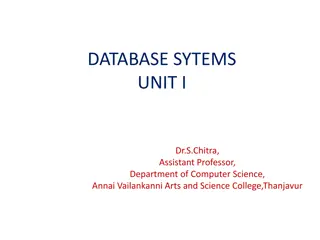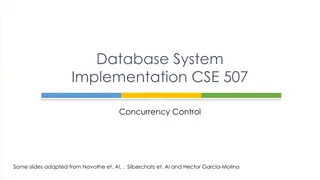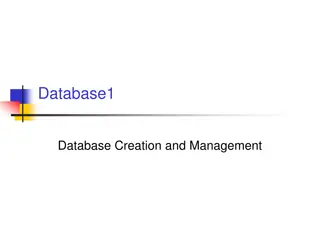Database Systems: ACID Properties and Conflict-Serializability
ACID properties of transactions in database systems and delve into conflict-serializability concepts. Explore two-phase locking protocol, transaction atomicity, consistency, isolation, and durability. Learn about transaction conflicts, swap operations, and conflict-serializability algorithms.
Download Presentation

Please find below an Image/Link to download the presentation.
The content on the website is provided AS IS for your information and personal use only. It may not be sold, licensed, or shared on other websites without obtaining consent from the author.If you encounter any issues during the download, it is possible that the publisher has removed the file from their server.
You are allowed to download the files provided on this website for personal or commercial use, subject to the condition that they are used lawfully. All files are the property of their respective owners.
The content on the website is provided AS IS for your information and personal use only. It may not be sold, licensed, or shared on other websites without obtaining consent from the author.
E N D
Presentation Transcript
Reforming Heath Policies : United Kingdom and USA Marc SMYRL Ma tre de Conf rences en Science Politique Universit de Montpellier
Class Outline 1) Building a comparative model A) From situations to problems B) Institutional context 2) Two national examples A) Problems and institutions in the UK B) Problems and institutions in the USA
Part One 1) From Situations to Problems We must understand why some situations (but not others) become the object of public policy 2) The Institutional context Why is it easier for public authorities to take some sort of policy actions than others?
From Situations to Problems 1) Is there a problem at all? 2) Is there a solution, even in principle? 3) Is public authority the best place to bring about a solution and only if the first three questions have a positive answer: 4) What policy should be put in place?
How are Problems Defined ? If a problem exists, it must be situated : to what domain does the problem belong? Example of health policy: to which domain does the problem belong? Medical Economic Social Moral Security Etc.
Where can Solutions be Found? Once a domain is identified, solutions depend on the framework chosen For a problem in the economic domain, should we use : A market-based framework? A solidarity-based framework? A planning-based framework? For a problem in the medical domain, should we use: A technological framework (centered on hospitals)? A public health framework focused on primary care and prevention? An alternative framework that goes beyond traditional medicine?
Frameworks and Behavior From the chosen framework come beliefs about preferences and expected behavior Who is self-interested or altruistic? Who has the needed knowledge and skills? What does the public want? More generally: who can be trusted?
Frameworks and Actors Depending on the Framework retained, different types of actors will play a central role Should health policy reform empower: Doctors Administrators Public sector regulators or inspectors Private sector enterprises
Answers precede questions Actors often have predetermined answers to questions of domain and framework. These can be based on : Ideology Personal experience The point of view of a trusted person or institution Professional or institutional self-interest
Solutions Precede Problems The solutions generated by a given framework have a long life Examples from economics Planning Markets Regulations
Instruments and Indicators Events can create now problems at any time, but these will often be placed in preexisting categories. It is important, accordingly, to specify the targets of public action. When a problem becomes the target of public action: One or more instruments (sets of concrete measures) are applied Measurable indicators are found both for the problem and for the solution
The Importance of Existing Policy Reform never begins from a blank slate. It is both impelled and constrained by existing policy. Who are the winners (and losers) of the existing system? What are its perceived failings? Does it have general popular support?
The Institutional Context Getting from idea to policy depends in part on the context of rules and organizations in which decisions are taken. 1) Who decides? 2) What rules govern the decision-making process? 3) Who can prevent any decision from being made?
Who Decides ? This is the central question of politics Who can select among possible questions and answers? More include both political and technical actors May or may not be publicly visible What coalition is necessary in a given setting for any decision to be taken and implemented?
What are the Rules ? These are institutions in the strict sense Is the regime democratic or authoritarian? What role for the executive, in the legislature? Is there a role for courts or other bodies? In a legislative (or judicial) context, what majority is required??
Actors and Veto Points Certain actors can block decisions, even if they cannot impose their own choices Official or institutional veto points Veto points kinked to majority formation Veto points outside government (social, religious, etc.)
Part Two Two National Examples THE USA and UK: two Anglo-Saxon states with market economies. 1) Cognitive differences (answers to the universal questions) 2) Institutional differences (rules and structures)
In the UK : Permanent Reform Since the end of the 1980S, reform of the NHS has been quasi-constant. Why? 1) Reform as such is a political resource 2) Relatively few veto points 3) Consensus neither on problems nor on solutions 3) Strong consensus on institutions : Save the NHS
Policy Inheritance National Health Service created by Labour governments in the 1940s but has become strongly consensual Universal coverage paid for by general taxation Free at the point of service Hospitals (but not primary care or specialized clinics) are nationalized but other care is paid for
Institutional Context Strong Prime Minister but only if there is a stable parliamentary majority Important role for technical advisors Majoritarian parliamentary system with little power for the minority First past the post electoral system favors the largest parties
What are the (perceived) problems Waiting times are too long Quality of care Excessive fragmentation: hospitals; primary care; social care
Competing programs of reform Internal market (waiting times are the problem; competition is the answer) Arms-length regulation: (quality is the problem; regulatory agencies are the solution) Integrated care: (fragmentation is the problem; coordination at the local level is the solution) => All are pursued more or less simultaneously
USA : Is Reform Impossible? Since the 1960s, only one -- limited -- reform has been passed: the Affordable Care Act (Obamacare) General dissatisfaction with the existing system (but for contradictory reasons) No consensus on questions or answers Many veto points in and out of government General distrust of public authority => All very different from the UK
Policy Inheritance The accumulation of distinct reforms Public funding for private insurance linked to employment (1940-1950) Health coverage for people over 65 -- Medicare (1960) Coverage for (some) low-income persons -- Medicaid (1960) Coverage for infants and young children -- SCHIP (1990)
Institutional Context The American system is characterized by the multiplication of veto points Institutional veto: President and Congress Political Veto: parties and lobbies Social Veto: public distrust of government but also major private-sector actors such as insurance or pharmaceutical interests
Is the System Unpopular? Too expensive (but for whom)? Imperfect coverage (but is this a public-policy problem?) Too much (or too little) for the federal government => Americans do not agree on the questions, let alone on the answers
2008-2010 An exceptional moment and a limited outcome Unified (but temporary) control of institutions Support of major economic interests (medical associations, hospitals, insurance companies) Even so, the outcome is limited, it remains contested, and further reform is impossible for the foreseeable future
Conclusions : US and UK The United Kingdom Single all-encompassing system Accumulation of visible but uncoordinated reforms Consensus on the importance of preserving NHS but not on the means to do so The United States Accumulation of historical elements -- no system as such Few visible reforms NO consensus on the preservation of a system























